Trees surely are gentle giants. They provide us with so many benefits. The most notable being the fresh air we breathe. Interested in these gentle giants? Read on, then. Here in this article, we have a list of 40 types of trees you should know.
There are many trees in the world. To make things simpler, they are divided into two main categories. The first category is deciduous trees and the second, evergreen trees. We explain each briefly below.
Deciduous trees
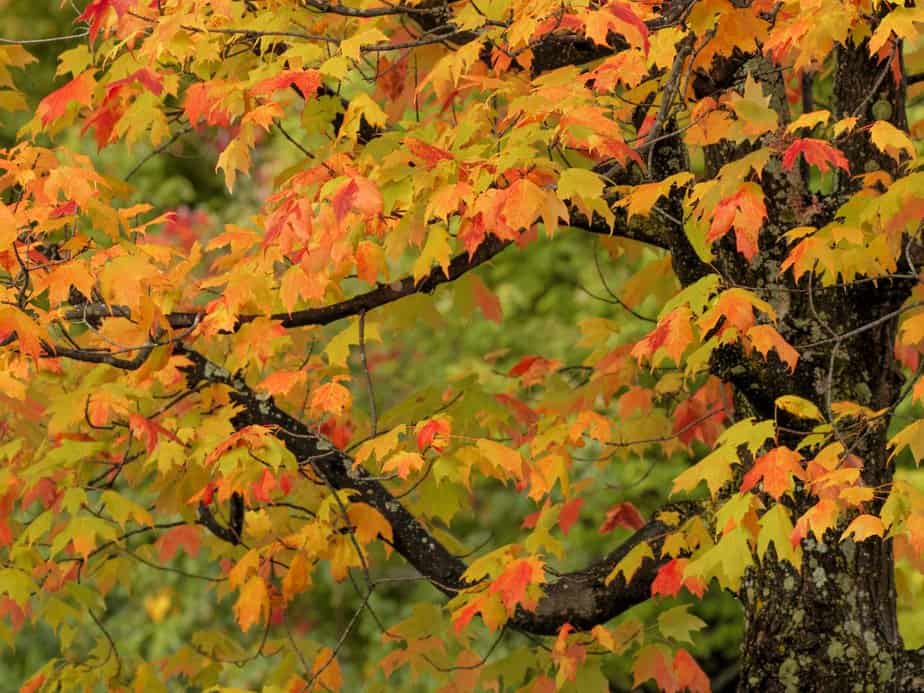
You probably have seen a tree whose leaves are changing color and then entirely shed them as winter is coming closer. Then, when spring comes, the same tree starts growing new leaves.
The tree we are talking about is an example of deciduous trees. Deciduous trees, also known as hardwoods, are a type of tree that does the above to prepare for winter.
During winter, there is not enough sunlight for these trees to do photosynthesis. Because of this, these trees go dormant during the cold months. They don’t put any energy towards growth during this time.
Deciduous trees might look like dead trees while they are dormant. But they are very much alive. The things they do is to conserve energy. Once spring arrives, these trees will grow leaves again.
Evergreen trees
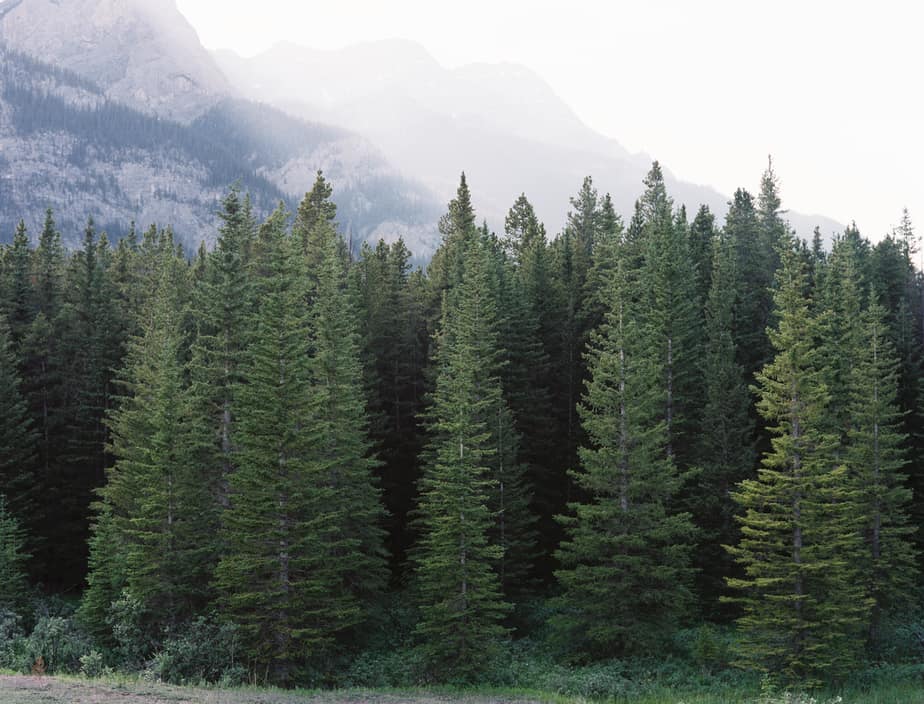
As the name implies, evergreen trees are types of trees that are green all year round. Yes, even in winter. Unlike deciduous trees, changing seasons does not affect evergreen trees.
Interestingly enough, there are some evergreen trees that shed their leaves. This shedding, however, is neither caused by a seasonal or an annual occurrence.
Rather, it is caused by an unexpected environmental phenomenon.
Another interesting thing about evergreen trees is that most of them are conifers. If you don’t what conifers are, they are trees that have cones and needle leaves.
Not all conifers are evergreen trees, though. Some of them are deciduous trees.
40 Types of Trees
Types of Deciduous Trees
1. The Flowering Dogwood Tree
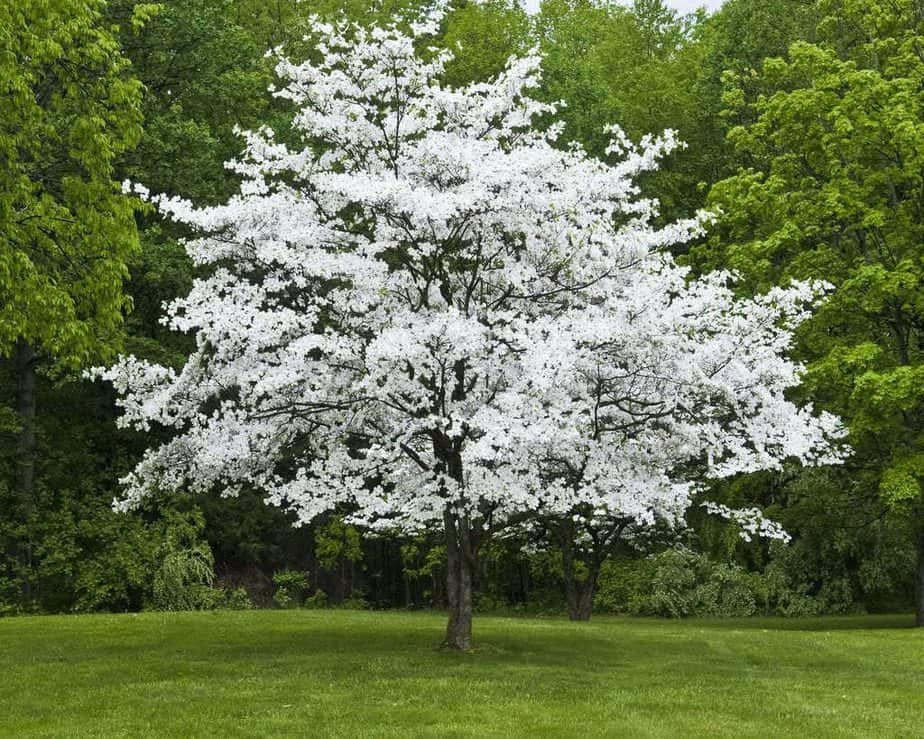
The flowering dogwood tree is an ornamental, small-sized deciduous tree often found in northern Mexico and North America.
As the name suggests, the tree is known for its white and light yellow flowers, which bloom during spring. The flowers are the reason why the tree is used as an ornament.
The flowers are not the only good things about this tree. The tree has gray-brown wood that is hard, dense, and coarse-grained. Due to its good quality, the wood has been used to make lots of items.
For example, wooden rake teeth, butcher’s block, tool handles, golf club heads, and even jewelry boxes.
The leaves are oval-shaped. What is interesting about the leaves is that they change color into a gorgeous brown-red when fall comes.
2. The Black Willow Tree

The black willow tree is a medium-sized deciduous tree. The tree is commonly found in Europe and North America. The tree has the most widely spread species compared to other types of trees on the list.
The black willow tree can grow in various environments, but it grows best when grown in moist or wet soil like along streams or near lakes.
The black willow tree is valued for its wood. The wood is, however, not used for timber production as it is crooked, weak, and soft. Rather, it is used for boxes, excelsior, pulp, and even used to create artificial limbs.
The bark of this tree is thick, rough, and scaly. The bark of a mature black willow tree is dark brown while the bark of a young one is light brown.
The leaves of the black willow tree are dark green and have a serrated margin.
3. The Black Walnut Tree
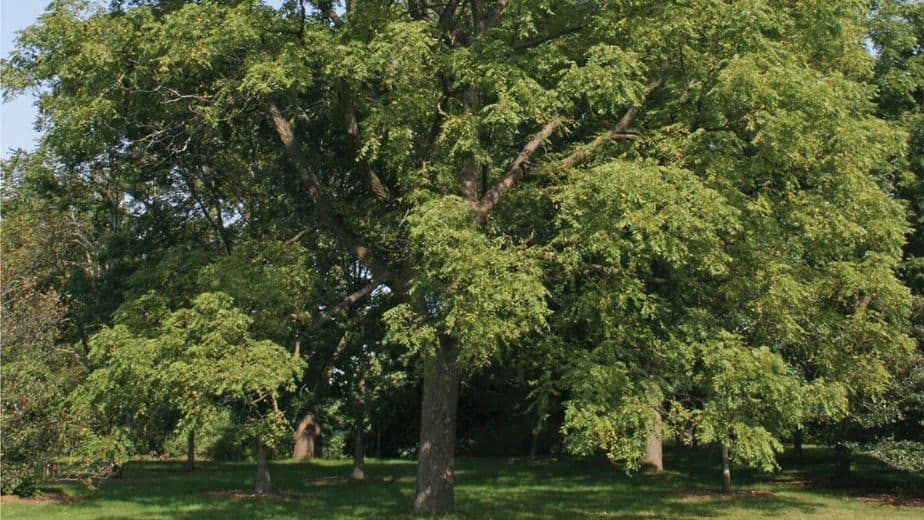
The next deciduous tree is the black walnut tree. Commonly found in Africa, North America, and some areas in Europe, this tree has a medium to large size.
The tree grows best in rich, well-drained soiled bottomlands. The black walnut tree is very popular thanks to its edible nuts and high-quality wood.
The wood of the black walnut tree has a rich brown color. The wood is hard, durable, and strong. While the wood is hard, it is easy to work with.
Moreover, the wood can be polished with finesse, resulting in high-quality products. Some of the products made from its wood include high-end furniture, cabinet, and interior works.
The bark of this tree is brown-gray. As the tree gets older, the bark sheds off, revealing the infamous beautiful brown color inner bark.
4. The Serviceberry Tree
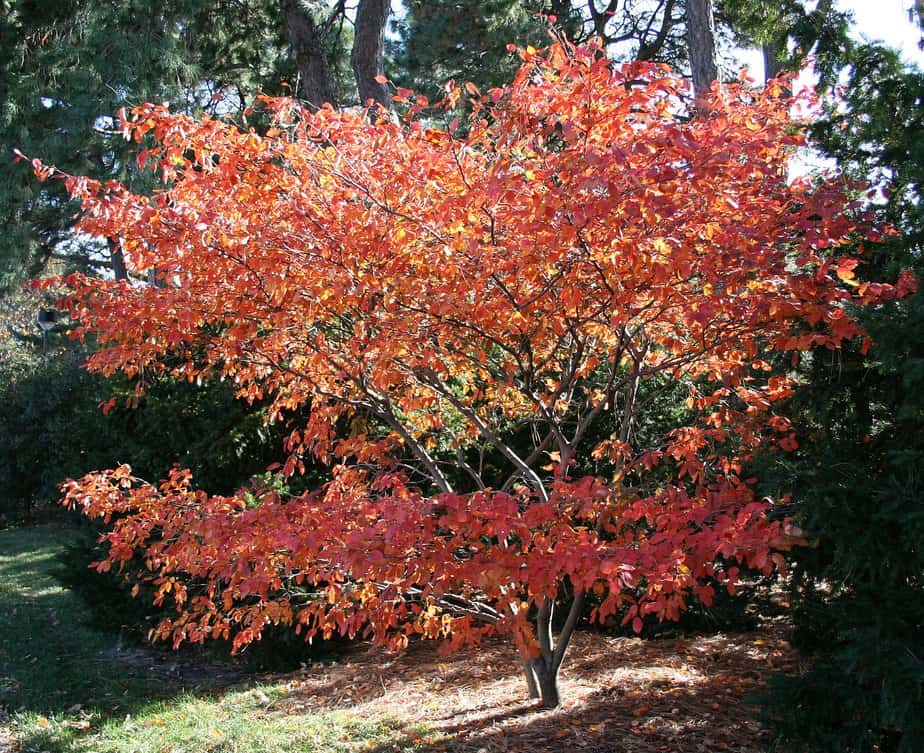
Due to its small size, the serviceberry tree can be considered as either a deciduous tree or shrub. The tree is commonly found on hills, along streams, riverbanks, and sometimes, on highlands.
A few species of the serviceberry tree are native to the United States and Canada while some other species can only be found in Europe and Asia.
During spring, the serviceberry tree blossoms very beautiful flowers.
The wood of the serviceberry is coarse-grained, heavy, and strong. Yet, despite these appealing qualities, the wood possesses no real value for timber. In rare cases, the wood is used to make tool handles.
The serviceberry tree has smooth bark that is brown-gray in color. The tree has simple-shaped leaves that have sharp-pointed tips.
5. The Eastern White Pine Tree
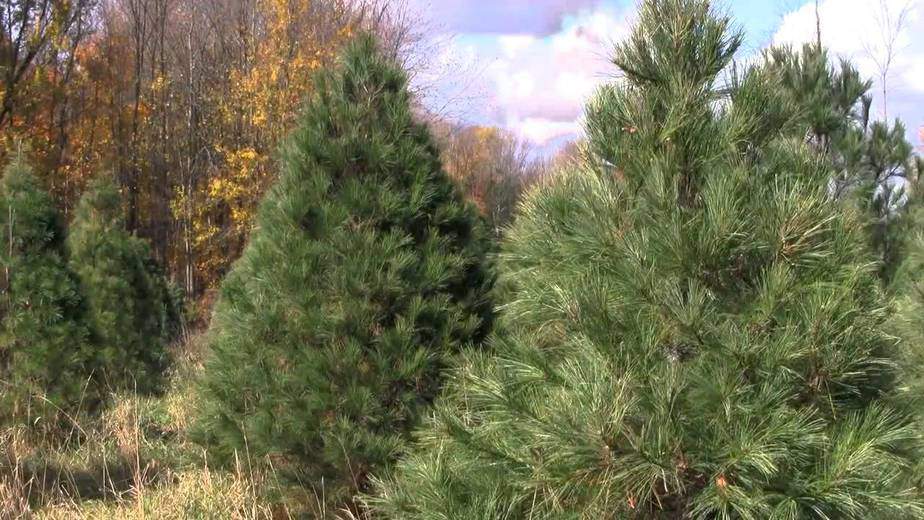
The eastern white pine tree is among the most unique types of trees on the list. Why? Because it is a deciduous conifer tree. Conifer trees are often evergreen trees. This one is different.
The wood of this tree has an excellent quality. It is not a surprise that the tree once held the title of lumber industry’s most important species.
Today, it is no longer the most important species in the industry as, unfortunately, the tree has been over-logged.
The wood of this tree is light brown in color, soft, even-textured, and best of all, easy to work with. Due to these qualities, the wood is often used for sashes, interior trims, boxes, buckets, and doors.
The bark of the eastern white pine tree is thin, smooth, and green in color. As the tree gets older, the bark turns grey and brown with deep furrows.
6. The American Larch Tree

Also known as the tamarack, the American larch tree is both a deciduous and coniferous tree. The American larch tree is native to Canada, but it can be found in various places in the United States.
The American larch tree can be both deciduous and coniferous due to having cones and needles. Yet, despite having that kind of leaves, the tree still drops seasonally, unlike most other coniferous trees.
The wood of the American larch tree is light brown. The wood is strong, hard, and heavy. The tree’s wood is often used to create snowshoes, while the bark is used as medicine.
The bark of the American larch tree is light gray and smooth. As the tree gets older, the bark’s texture becomes less smooth and rougher over time. The color also changes into a brown-red.
The leaves of this tree change their appearance as the season changes. Most of the time, however, they stay pale green.
7. The European Larch Tree
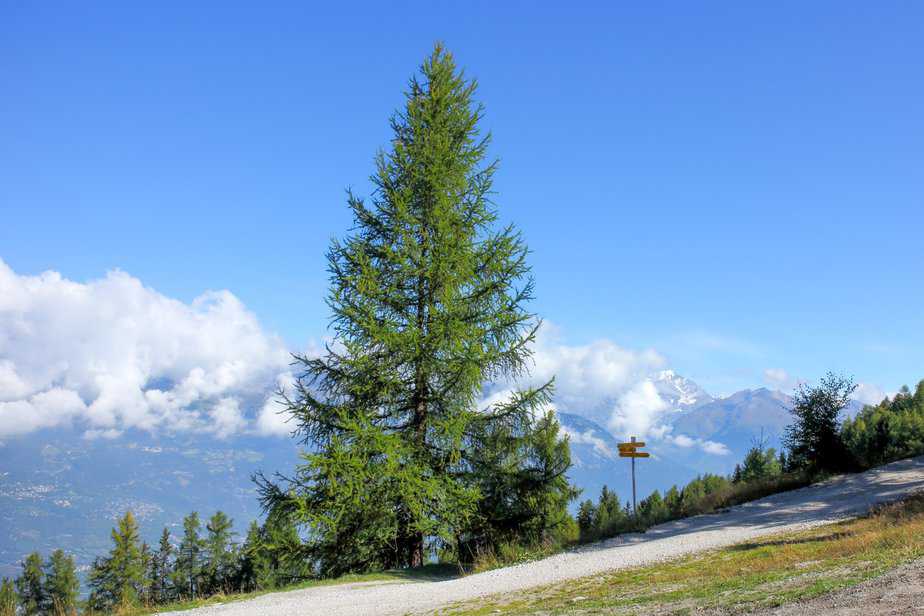
The European larch tree is another deciduous conifer tree. The tree is commonly found in Europe, in the Alps and the Carpathian Mountains. You know what is amazing? The tree can live up to 1,000 years.
The wood of this tree is strong, durable, and heavy. Yet, it is flexible enough to work with. The wood is commonly used for fence posts and yacht making.
The bark of the European larch tree is smooth and has a dusty brown color. As the tree ages, the smooth bark peels off, revealing the beautiful brown surface underneath.
The leaves of this tree look similar to American larch tree leaves.
8. The American Hornbeam Tree
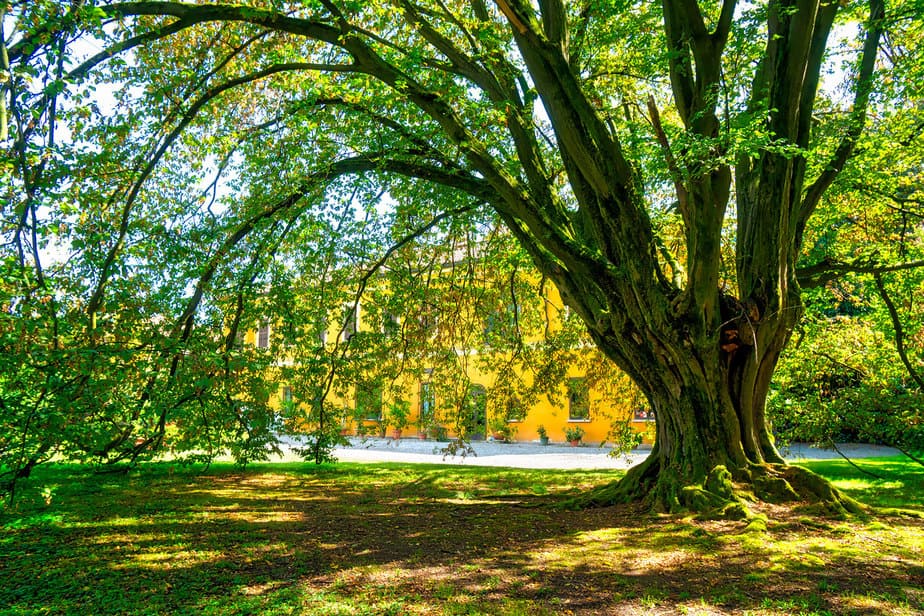
Many types of trees on the list are medium- and large-sized. The American hornbeam is among the smaller ones. This bushy, deciduous tree is native to North America.
The tree is most commonly found in Texas, Maine, Minnesota, and Quebec. The tree is usually planted along watercourses and on the edge of swamps.
Don’t be mistaken by the size of the tree, however. Despite its small size, the tree possesses a strong, hard, coarse-grained, and very heavy wood. As for the color, the color of the wood is light cream.
The wood of this tree is often used for various kinds of tool handles.
The bark of the American hornbeam is attractive as it is thin, smooth, and dark gray-blue in color. If you’re planning to have a home garden, American hornbeam would be a nice addition.
The leaves of this tree are simple and have a light serrate along their margin.
9. The Black Locust Tree

The black locust tree, also known as the false acacia, is a deciduous tree native to North America. The tree is considered an invasive species due to its ability to populate an area.
The tree can grow in various environments. It doesn’t demand much when it comes to soil. That said, the tree grows best in a moist area where it can get plenty of sunlight.
The black locust trees have been cultivated in many other places outside their native land. For example, Canada, South America, New Zealand, Europe, Asia, and even Africa.
The wood of the black locust tree is the hardest hardwood in North America. Due to its toughness, the wood is considered to be very valuable.
The wood is commonly used for small boats, fence posts, flooring, and furniture.
The black locust tree has a very straight trunk. Its crown is narrow and its leaves beautiful. The tree also blossoms gorgeous flowers that have a butterfly-like shape.
10. The Hawthorn Tree
The hawthorn tree is among the types of trees on the list that can be found in many places. The tree can be found in North America, Europe, and Asia.
The hawthorn tree is not a single species. Rather, it is a genus of a tree to which a few hundred species of tree belong.
Despite numbering hundreds, hawthorn trees share a lot of similarities. Because of this, it can be difficult to distinguish one species from another.
The hawthorn trees as a whole are quite popular ornamental trees. They produce amazing flowers that are not only delightful to see but also delightful to smell.
The hawthorn tree is important to some cultures, seen as a symbol of fertility by some and an instrument to ward off evil to others.
11. The Sycamore Tree
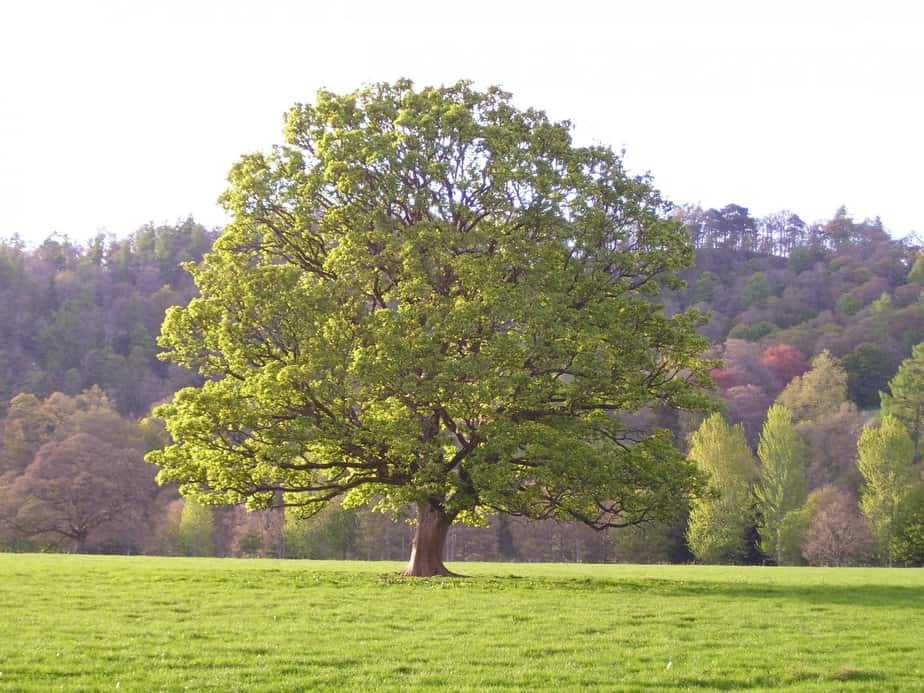
Commonly found in the Northern Hemisphere, the sycamore tree is a large deciduous tree. The tree is often found in areas like along streams and at river bottoms, where the soil is fertile and moist.
Sycamore trees grow best in such areas, but they can grow in drier areas as well. In fact, many of them are planted in drier areas.
The sycamore has a brown-red colored wood that is hard, tough, and coarse-grained. Although the wood is difficult to work with, it is commonly used for butcher’s blocks, novelties, crates, and boxes.
The tree of this bark has different shades of color.
At the bottom half of the trunk, the color of the bark is dark brown. The bark peels off as it starts to reaches the top of the tree, revealing a bright green-yellow inner bark.
12. The Eastern Cottonwood Tree

Many types of trees on the list are long-lived. The same cannot be said about the eastern cottonwood. This deciduous tree can grow large in a short time but it is short-lived.
Commonly found in Canada, the United States, and Mexico, this tree grows bests in areas like alongside streams and lakes, where the soil is rich and moist. Except for highlands, the tree can be planted anywhere.
The eastern cottonwood tree is valued for its appealing look. It is no wonder that the tree is used as an ornamental tree. Add the tree in any space and it will make the space looks aesthetically better.
The wood of the eastern cottonwood tree has a dark brown color. The wood is light, soft, and weak. Despite these, the wood is often used for pulp and boxes.
This tree has a light green bark that is smooth. As the tree gets older, the bark becomes rougher and rougher. The color also turns into an ashy gray.
The leaves of this tree are long, have a triangle shape with incurved teeth along their sides.
13. The Cucumber Tree
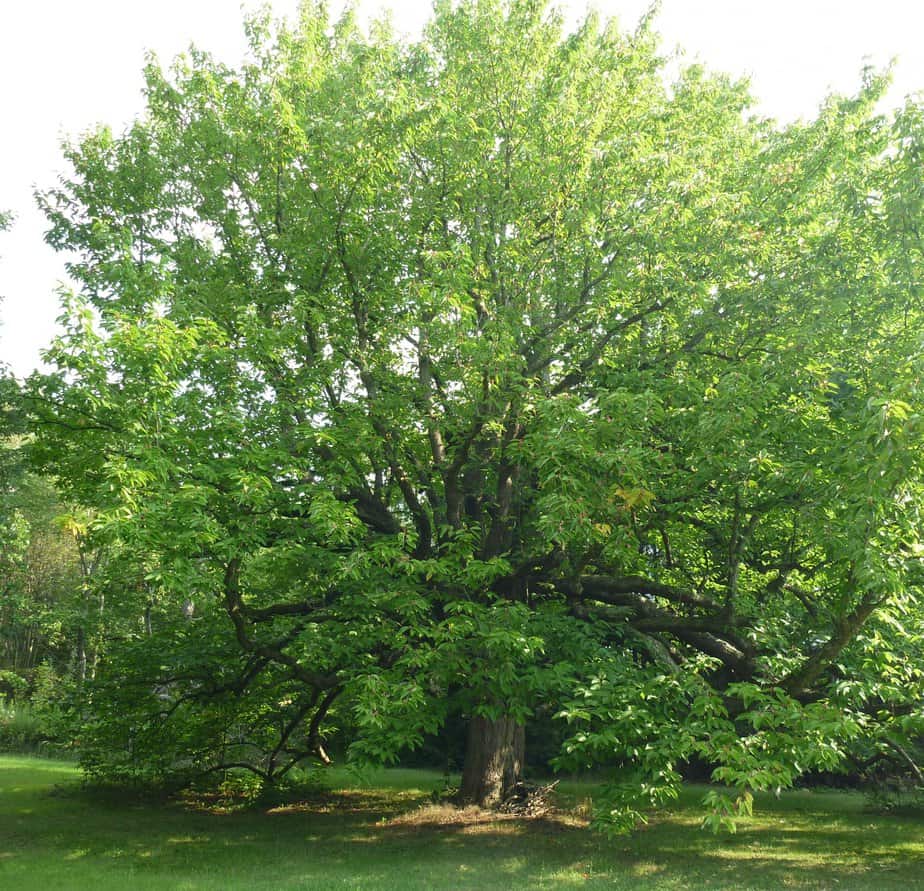
Commonly found in the United States, specifically in southern Ontario and the eastern part of the States, this deciduous tree is named after its cucumber-like fruits.
The cucumber tree has a light brown-yellow wood. The wood is coarse-grained, soft, light, and brittle. The wood is rarely used. Instead, the tree is valued for its look.
These trees are commonly planted as ornamental trees, albeit unlike other magnolia tree species. The tree produces beautiful flowers that grow on its canopy.
The bark of this tree is brown-gray. The leaves are pointed at their tip and are simple. Another appealing aspect of this tree is its twigs, which give off a nice scent.
Birch Trees
Known as pioneer trees, birch trees are the trees that germinate and repopulate an area where some sort of disaster happens (like forest fires, for example).
Several varieties of this tree exist, but we will focus only on the gray birch, yellow birch, black birch, and paper birch. These types of trees share many similarities and surprisingly enough, differences.
14. The Gray Birch Tree
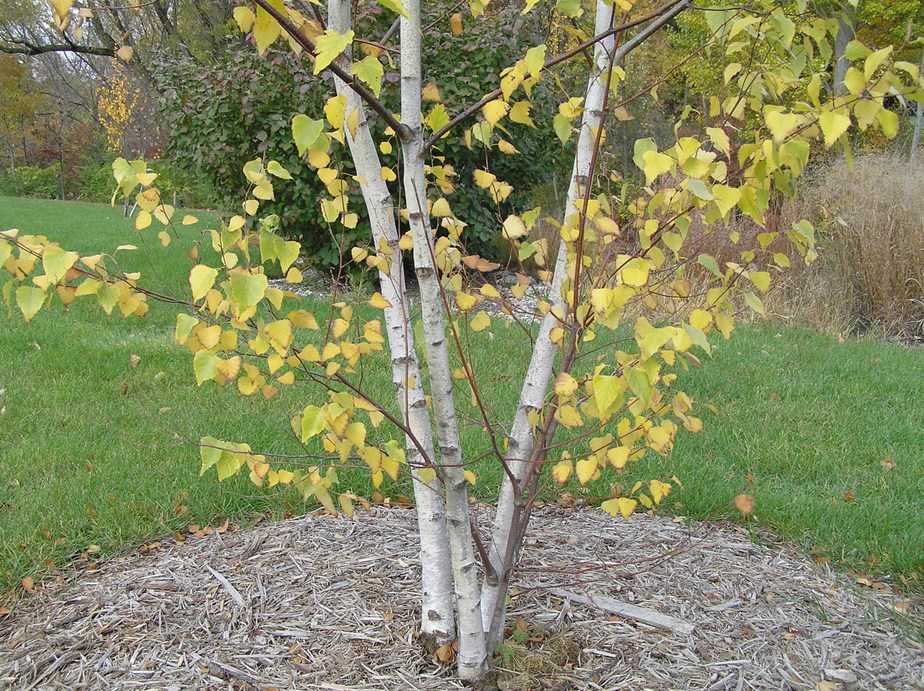
Another example of deciduous types of trees is the gray birch. This tree is native to Canada, specifically Ontario and Nova Scotia. These trees can also be found in the United States.
Unlike the other birches, this one grows best in areas like mountainsides where there the soil is rather dry and has low nutrient contents. The gray birch can grow to 20 to 30 meters in height.
The wood of this tree is quite hard, making it the main option for furniture, spools, and manufacturing. Because the wood has high oil content, it makes great firewood. Yes, even when the wood is wet.
The bark of the gray birch is thin and smooth. The bark doesn’t peel off quite well, unlike the bark of paper birch and black birch.
15. The Yellow Birch Tree

This medium-sized, deciduous tree is native to the northeastern part of North America. The tree grows best in areas like the Appalachian Mountains, where the soil is rich and moist.
The wood of the yellow birch tree is light brown in color. The wood is strong, hard, and coarse-grained. The quality of the wood is good. Not surprisingly, the wood is often used for many things.
From lumber, agriculture, woodenware, interior design, furniture, flooring to airplanes. The wood can also be used as fuel, if need be.
The bark of a young yellow birch tree is bright yellowish silver. But, as the tree grows, the bark starts to peel off, revealing a dark brown-red color underneath.
The leaves are similar to the leaves of the black birch tree. Yes, including the hairiness.
16. The Black Birch Tree

The black birch tree is a medium-sized deciduous tree. This tree is most commonly found in the southern part of Ontario and southern Maine, although the tree can also be found in the Appalachian Mountains.
The black birch can grow really tall. The tallest recorded black birch tree is 35 meters tall. As for age, the oldest black birch tree is 368 years old.
The tree grows best in slightly acidic soil that is neither too moist nor too dry. While the tree grows best in climates with hot summers, it can survive colder winters with no difficulty.
The black birch tree has dark brown wood that is strong, coarse-grained, and hard.
The wood of this tree is often used for fuel and furniture. In fact, it is not uncommon to find this wood replacing more expensive woods like cherry and mahogany.
17. The Paper Birch Tree
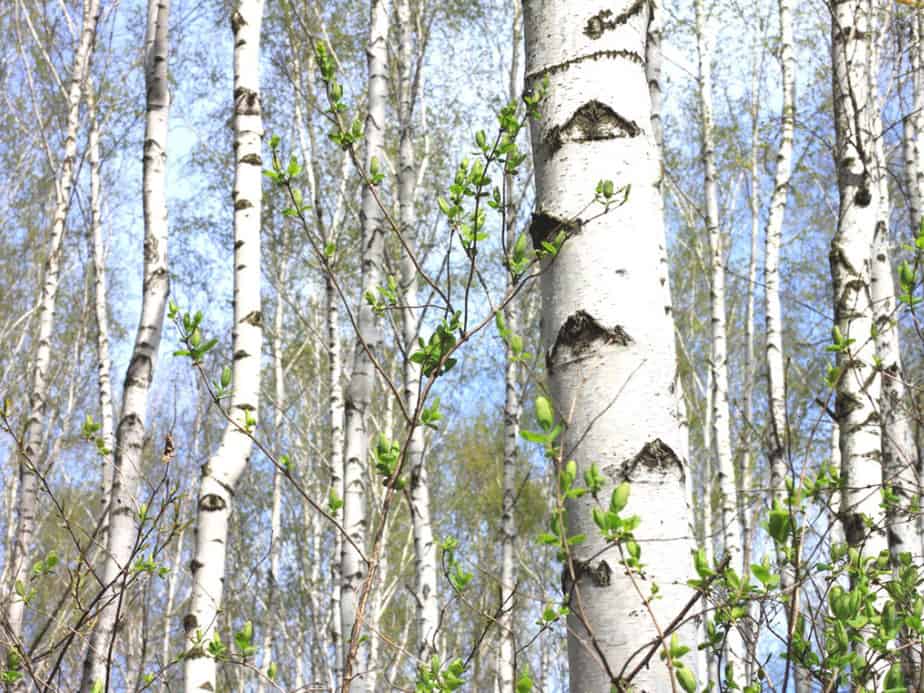
This deciduous tree is a small-sized and short-lived tree. The paper birch, like its birch siblings, is commonly found in North America.
The tree gets its name thanks to its thin and white trunk which can be peeled off as paper would.
The paper birch tree can grow in various kinds of soils but it grows bests when planted alongside lakes, streams, and swamps.
The tree has light brown wood. The wood is tough, hard, strong, and, interestingly enough, light. Due to these qualities, the wood is commonly used for spools, woodenware, and wood pulp.
The bark of the paper birch tree has a golden or reddish-brown color. As the birch tree ages, the color changes to chalky white.
The leaves of the paper birch tree are similar to other birches.
Elm Trees
One of the most defining characteristics of elm trees is their durability. Yes, elm trees are tough. They are resilient and can grow to large sizes.
Unfortunately, the once prevalent and prospering species have been attacked by a devastating disease known as Dutch Elm disease.
Although some species are not as susceptible to others, the effect is still devastating. We can consider ourselves lucky to see some elm trees communities still exist today.
18. The English Elm Tree
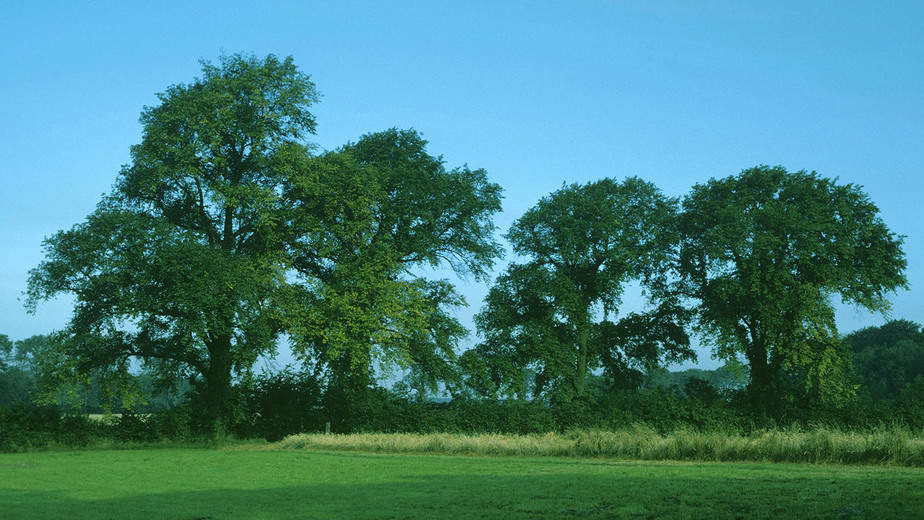
A medium-sized tree, the English elm tree is a deciduous tree that grows quickly. This tree is most commonly found in Europe.
Back before the Dutch Elm disease came, the central-southern Europe fields were full of these trees.
The wood of the English elm tree was once considered highly valuable for manufacturing hollowed trucks and water pipes, thanks to the rot-resistant quality of the wood.
The wood is also used for pier construction, timber, and jetties.
In general, the bark of the English elm tree is dusty brown in color, rough, and scaly. The leaves of this tree have a light green color, which eventually changes to dark green as the tree reaches maturity.
In early spring, the English elm tree produces beautiful purple flowers, just before the leaves come out.
19. The American Elm Tree
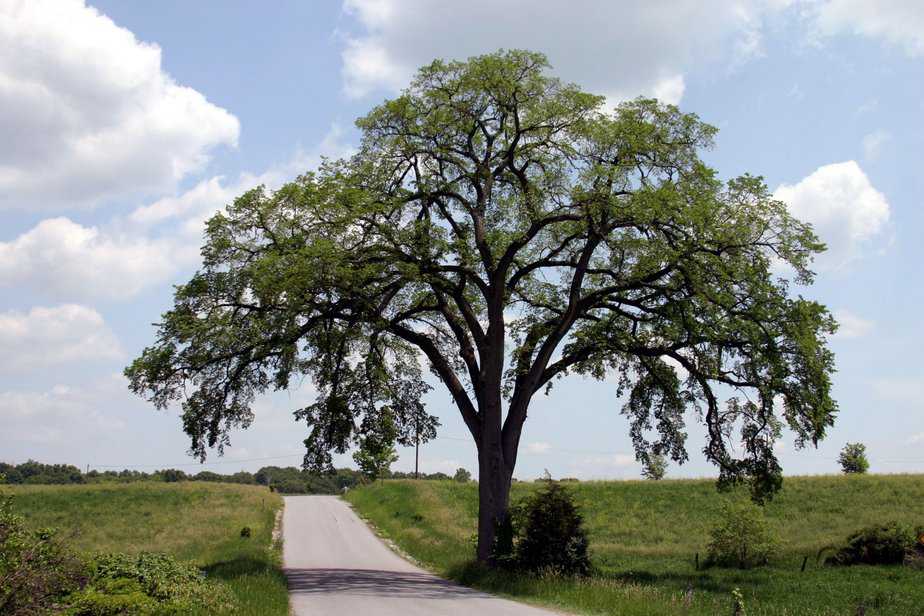
The American elm tree is another elm tree that can mostly be found in North America, particularly in Texas, Florida, Montana, Alberta, and Nova Scotia.
This deciduous tree grows to medium size. The tree is considered as among New York’s most popular and beautiful trees.
When it comes to wood, this tree has light brown wood. The wood is coarse-grained, heavy, tough, and strong. The wood is difficult to work with as well.
Despite being difficult to work with, the wood is commonly used for barrel staves, veneer, wheel hubs, and crates.
The tree not only offers useful parts but also an aesthetical value. This elm tree has a symmetrical crown, which looks amazing.
Although the tree is wonderful, it is among the victims of Dutch Elm disease. You can no longer see these trees at parks or on streets. That’s just how devastating the disease is.
20. The Slippery Elm Tree

Native to northern America, the slippery elm tree is a medium-sized deciduous tree. It can be found in Texas, Florida, Quebec, Maine, and North Dakota.
This elm tree thrives on fertile stream banks and slopes, but can grow in less ideal conditions as well.
The slippery elm tree has coarse-grained, hard, strong, and heavy wood. Although the wood has appealing qualities, it is rarely used for commercial purposes.
But when used, the wood is used to make fence posts, hoops, barrel staves, and ties.
The bark of this tree has been used as traditional medicine for a long time.
The bark is brown-gray and is usually different from that of an American elm tree. The inner bark has a white, slimy, glue-like substance from which the name “slippery” came from.
Hickory Trees
There are 18 species of this tree. The size of hickory trees varies from one species to another but they all are fast-growing and large hardwood trees.
Some of the most popular hickory trees are the pignut hickory tree, the bitternut hickory tree, and the shagbark hickory tree.
21. The Pignut Hickory Tree
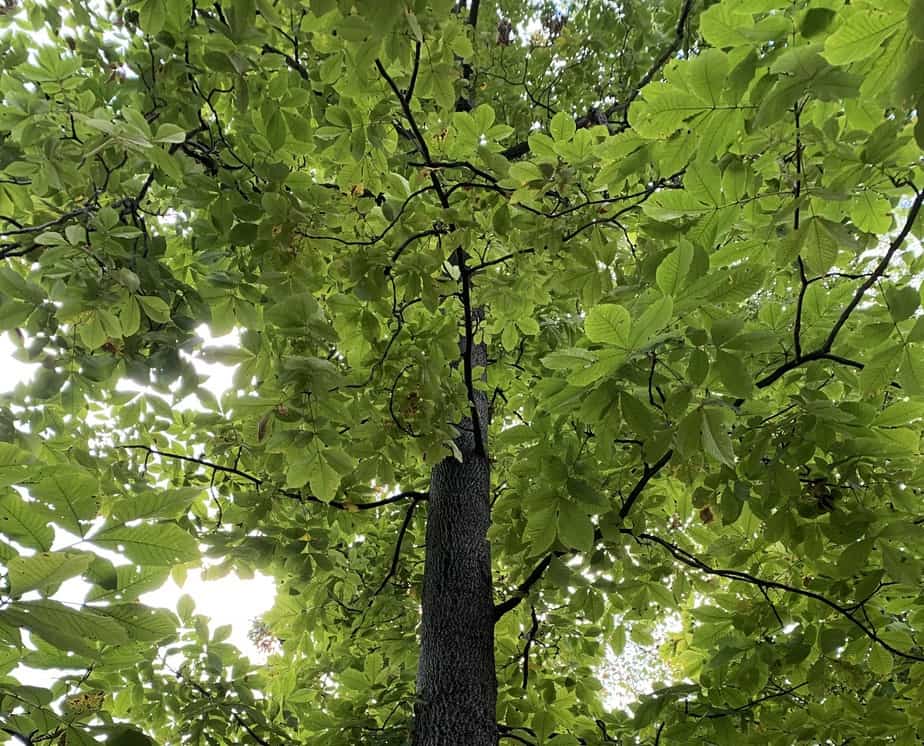
As our list has shown you, there are many deciduous trees in the world. Among them is the pignut hickory, a medium-sized tree that is mostly found in almost every state in the United States and Canada.
The pignut hickory is an upland species. It grows best in more humid climates but can also grow on dry ridges and hillsides well.
Unlike many types of trees on the list, this tree has little commercial value. Why? Because its wood tends to have internal discoloration, which is caused by birds and beetles that feed on the tree.
The tree has short branches, coarse bark, and an irregular-shaped crown. The leaves of the tree are compound which turns yellow and then drop as fall comes.
22. The Bitternut Hickory Tree

Unlike its sibling the pignut hickory tree, the bitternut hickory tree is a large-sized deciduous tree. The tree is mostly found in the North American region.
This hickory tree grows well in areas where the soil is rich and moist, but it thrives on wetlands like streams, ridge tops, hillsides, fields, and pastures.
The wood of the bitternut hickory tree has a dark brown color. The wood is hard, strong, and heavy. These qualities make the wood an ideal choice for furniture paneling, pulpwood, and lumber.
The tree has a lifespan of 200 years, making it the shortest living hickory trees as other hickory trees can live much longer than that.
This tree produces nuts but they are not edible as they have a very bitter taste. That’s right. That’s where the name “bitternut” came from.
23. The Shagbark Hickory Tree
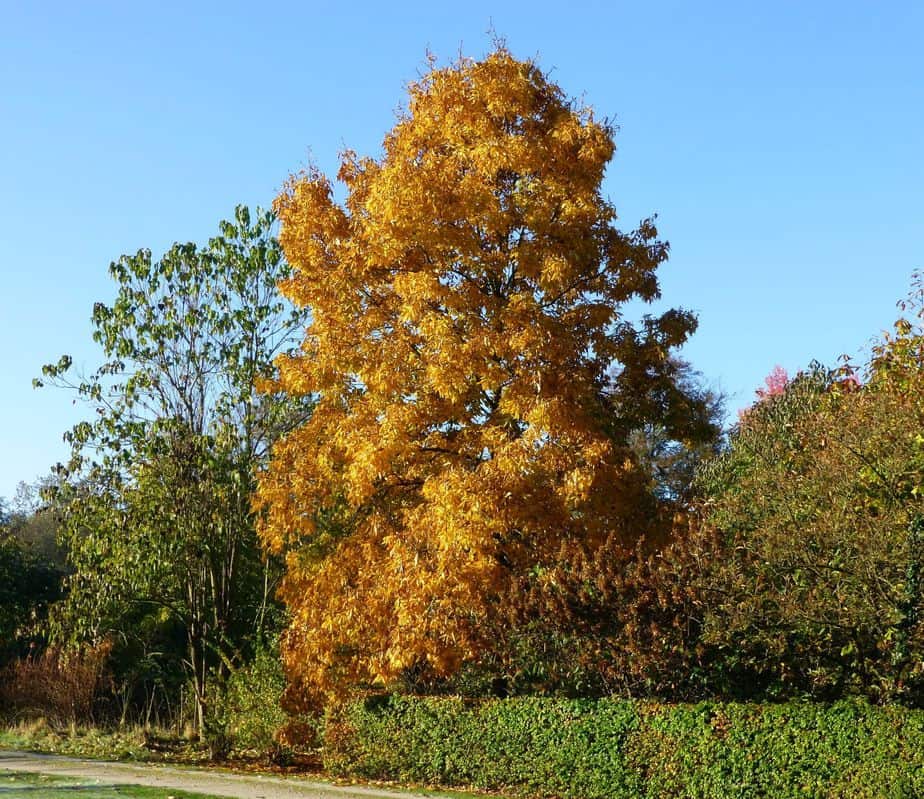
The shagbark hickory tree is among the longest-living and tallest trees in the world. The oldest known shagbark hickory tree is 350 years, while the tallest grow to up to 40 meters tall.
This hickory tree is mostly found in the northeast United States and southeast Canada.
The shagbark hickory tree has coarse-grained, tough yet elastic wood. This tree grows slowly, which is why it is not that popular in the lumber industry.
The wood, however, is sometimes used to make tool handles.
The bark of the shagbark hickory tree is light gray in color. The bark is smooth.
As the tree grows, the smooth bark starts to peel off. What is unique about this peeling process is that the bark peels off in long strips. The ends of the strips are loose, but the middle is attached.
Maple Trees
Maple trees are among the most popular trees in the world. The trees are especially popular in North America. Some of the most popular types are the sugar maple tree, red maple tree, and silver maple tree.
24. The Sugar Maple Tree
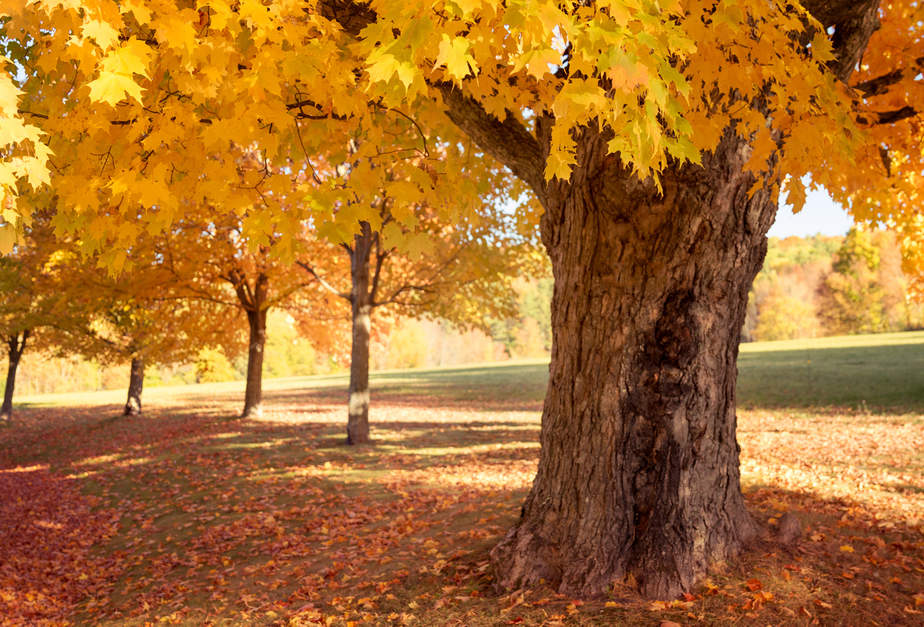
You’ve probably have seen or at least heard about this tree before. Yes, this particular maple tree is that famous, especially in Canada.
Native to Canada, this deciduous tree can grow to medium size. While being native to Canada, the sugar maple tree is widespread in North America.
The most well-known thing about this tree is, that’s right, its sap. The sap tastes sweet and is used to create tasty maple syrup.
The sap is not the only thing that the sugar maple tree offers, of course. The wood of the sugar maple tree is tough, coarse-grained, and strong. It has a fine surface.
Due to its quality, the wood is often used to make flooring, furniture, interior design, and fuelwood. Quality-wise, the wood of the sugar maple tree is among the best in the maple family.
The bark of an immature sugar maple tree is smooth and dark-gray in color. As the tree reaches maturity, the bark starts to become furrowed.
The leaves of the sugar maple tree have a similar shape to other maple tree leaves. The difference is that the sugar maple tree leaves are dark green.
25. The Red Maple Tree
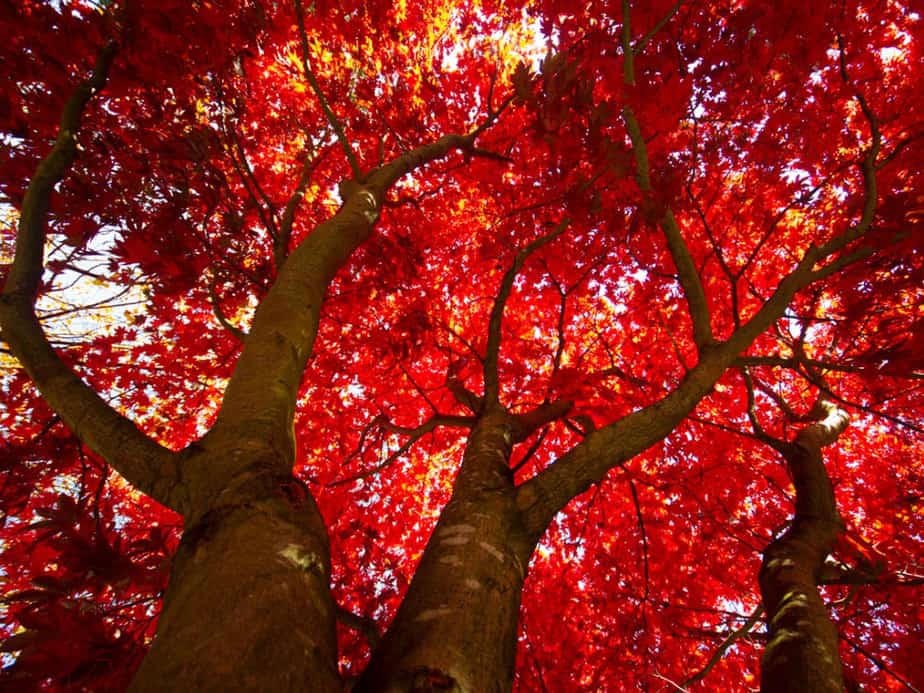
If you’re looking for the most beautiful deciduous tree, the red maple tree can fit the category easily. How could it not? During fall, the leaves, twigs, buds, and flowers of this tree turn bright red.
Of course, the redness of the tree makes a breathtaking scenery.
This tree is widespread all over North America. It can grow on moist slopes, in woodlots, and swamps.
The wood of the red maple tree is coarse-grained and strong. Because the wood is inexpensive, it is often used for baskets, crates, cheap furniture, and railroad ties.
The red maple tree has smooth, light grey bark. This bark eventually becomes rougher and darker as the tree gets older. The leaves have a simple shape, similar to other maple trees.
26. The Silver Maple Tree
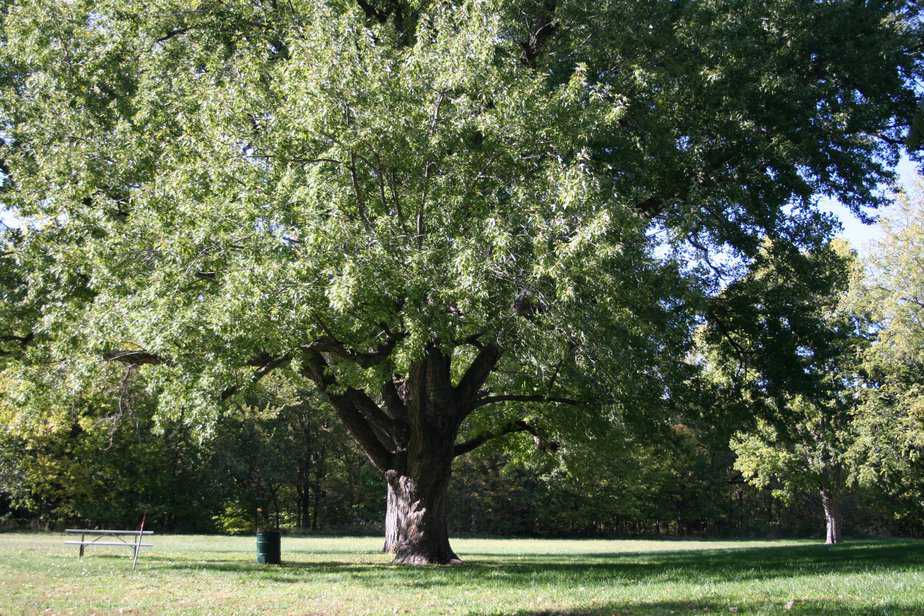
The last maple tree on the list is the silver maple tree. This maple tree is fast-growing, able to reach a medium size in a short time.
This maple tree is commonly found in Canada and the United States. Although the trees are widespread in both countries, silver maple trees are not as common as red maple trees.
The silver maple tree thrives on the same conditions as the red maple tree. The tree has little to no commercial value and is more often to provide shade.
The wood of this tree is weak, so if you’re planning to plant a silver maple tree, make sure it is far from your home, cars, or any other buildings, just to be safe.
This tree has smooth, reddish-gray bark. The color and the texture of the bark eventually changes into reddish-brown while the texture becomes flakey.
The silver maple tree has a silvery-white and green color, from which the name “silvery” is derived.
Oak Trees
There are nearly 300 known species of the oak tree in the world. Oak trees have many variations. Some oak trees thrive in forests and mountainous areas, some others thrive in sheltered valleys.
The most popular types of oak trees are the black oak tree, the white oak tree, the northern red oak tree, the scarlet oak tree, and the chestnut oak tree.
27. The Black Oak Tree

The black oak tree is a fast-growing, medium-sized deciduous tree commonly found in eastern and central North America. This tree grows well on dry grounds and gravelly soils.
The wood of this oak tree is heavy, hard, and strong although not as valuable as the wood of the red oak tree. The wood is commonly sued for construction, ties, and fuelwood.
The tree has smooth, dark brown bark. Over time as the oak tree grows, the bark’s color turns into gray-black while its surface becomes very rough.
Sometimes, the bark of the black oak tree starts to peel off, revealing a yellow-orange inner bark.
The leaves are simple and have bristles on the tips.
28. The White Oak Tree
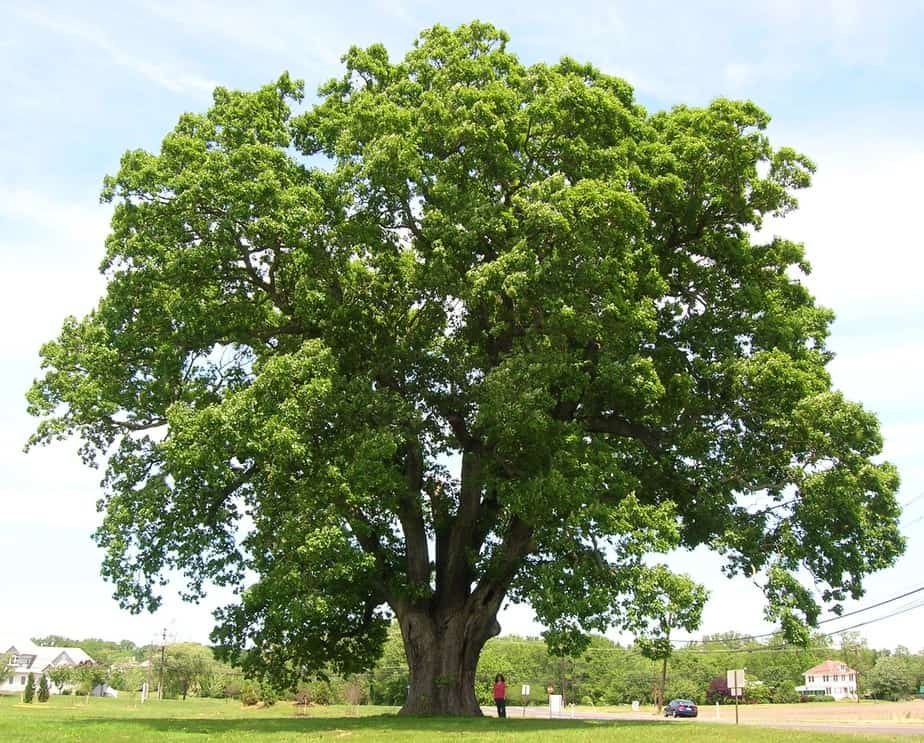
Let’s move on to the white oak tree now. This tree is among the most unique types of trees on the list. The tree is both deciduous and coniferous. It is among the few coniferous trees that are not evergreen.
The white oak tree is commonly found in eastern and central North America. The “white” on its name refers to the white trunk the tree has, which is something uncommon among trees.
When it comes to wood quality, the white oak tree wood is among the best. The wood is hard, durable, strong, and heavy.
It is hardly surprising that wood is used for many things, from general construction, flooring, to furniture.
The bark of this oak tree is usually white, although there are some trees that have ashy gray bark. The bark has scales and furrows, which get deeper as the tree gets older.
29. The Northern Red Oak Tree
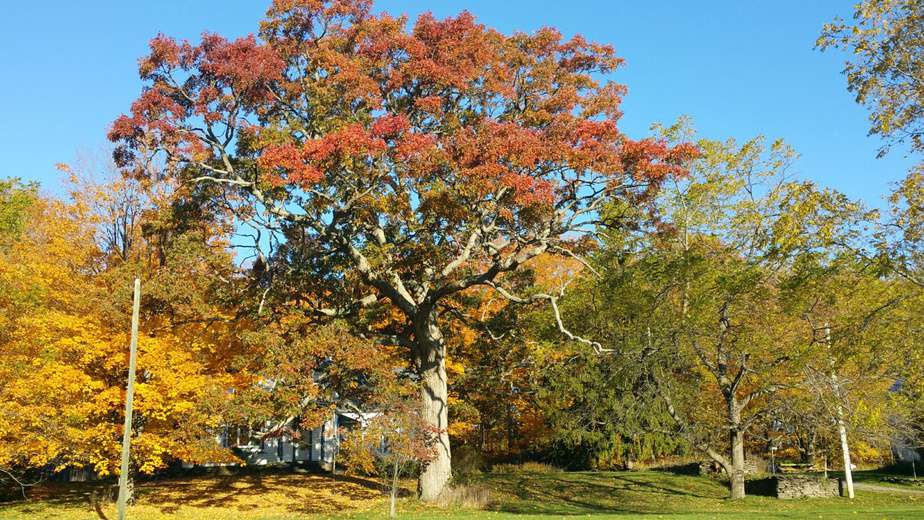
Although the northern red oak tree is mostly found in North America, the tree has great adaptability. IT can grow well in various conditions and soil types. The tree can grow to medium to hard size.
The name suggests the tree’s qualities. It is red all over, from the leaves, flowers, twigs, to heartwood. All of these are all red.
The northern red oak tree not only has an eye-catching look, it also has excellent quality wood. The wood of this tree is light brown in color, is hard and strong.
The wood is often used in general construction, ships, interior finishes, and furniture. Although the wood quality is good, it is less durable than the wood of the white oak tree.
Like most types of trees on the list, the bark changes color and texture as the tree grows. When young, the bark is smooth and gray-green in color.
When the tree gets older, shallow furrows are slowly revealed.
30. The Scarlet Oak Tree
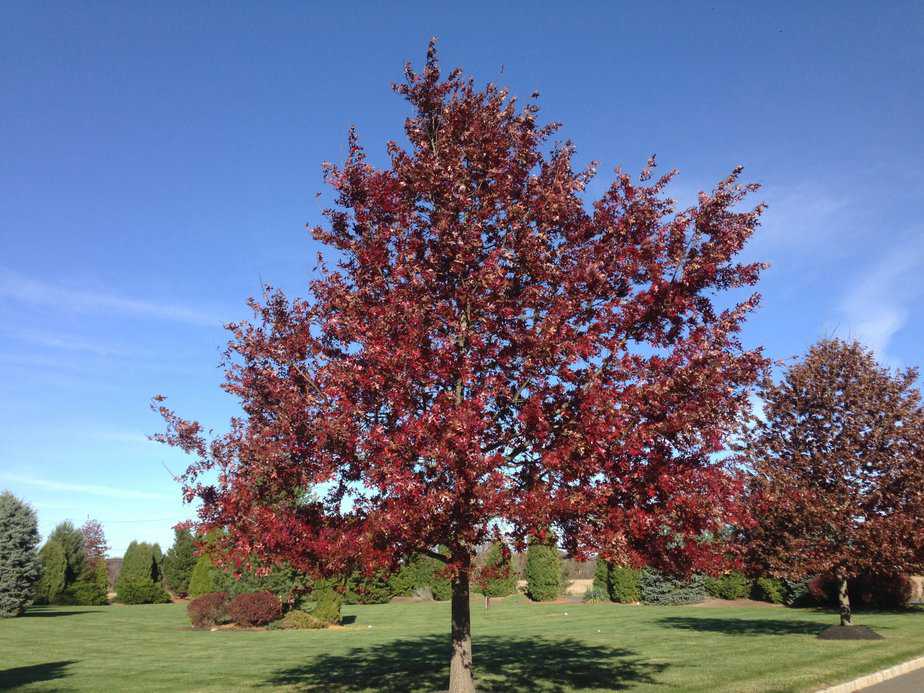
The scarlet oak tree looks similar to the northern red oak tree as both are red. The main difference between the two oak trees is that the scarlet oak tree’s color is more vibrant.
This deciduous tree can grow to medium to large size. It is native to the central and eastern United States.
What’s interesting about this tree is that its leaves stay attached throughout winter, creating a stunning look as the tree and snow contrast each other.
The wood of the scarlet oak tree is strong and coarse. It is mostly used for inferior constructions.
If you’re looking forward to improving your garden aesthetic, this tree will do the job well.
31. The Chestnut Oak Tree

The chestnut oak tree is a medium-sized deciduous tree that is commonly found in areas like drylands, hillsides, and rocky ridges. This tree is native to North America, most commonly found in the eastern US.
The wood of this oak tree is similar to that of the white oak tree although is inferior in terms of value. The wood is commonly used for rough construction and posts.
The chestnut oak tree has smooth bark, which eventually becomes rougher with deep furrows and rough ridges as the oak tree ages.
Likewise, the bark color also changes over time, from yellow-brown to dark brown. The leaves of the chestnut oak tree are simples and have a yellow-green color.
Types of Evergreen Trees
32. The Balsam Fir Tree

Let’s move on to evergreen types of trees now. The first evergreen tree on the list is the balsam fir. It is a medium-sized forest tree native to central and eastern Canada and the northeastern United States.
This tree is usually found in areas with cold climates. The tree grows around mountain ranges, flatlands, and wet swamps.
The wood of the balsam fir tree has a light brown color. The wood is light, soft, and coarse-grained. Because the wood has low durability, it is rarely used for lumber.
The tree, however, is mostly used as a Christmas tree. Another interesting thing about this evergreen tree is its needles, which not only fragrant but also stay fresh longer than that of other pine trees.
33. The Eastern Hemlock

Evergreen trees rarely like shade. This tree is an exception. The eastern hemlock tree is a coniferous tree that can grow large and live long.
The tree is native to North America, growing in areas like steep mountain slopes, shaded areas, and swamps border.
The eastern hemlock tree is considered a valuable forest tree.
The light brown wood of the eastern hemlock tree is coarse-grained and light. Due to these, the wood is often used as construction lumber in addition to pulp making.
The inner bark of this tree is both edible and medicinal, while the needles can be used to make tea.
The tree has lots of beneficial parts. It is no wonder the tree is considered a valuable forest tree.
34. The Australian Mountain Ash Tree
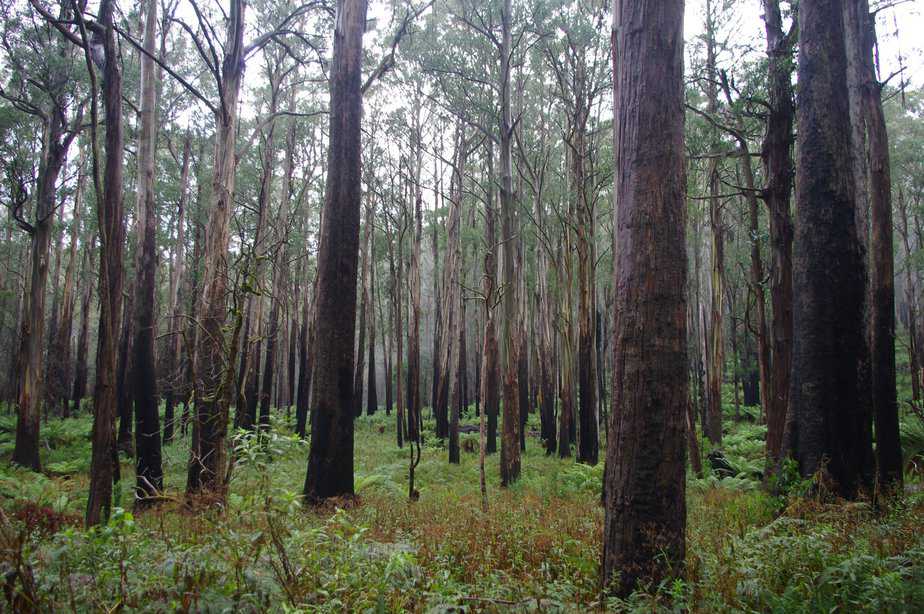
Eucalyptus is a genus to which over 700 species of trees, flowering plants, and shrubs belong to. The plants that belong to the Eucalyptus genus tend to have fibrous, smooth, or hard bark.
The leaves have sepals, petals, and oil glands. The fruit that Eucalyptus plants grow is called a gumnut due to its unique shape that resembles a woody capsule.
Native to Australia, Eucalyptus trees are known to survive wildfires, some disasters that are common in the region.
Only a few species of this tree can be grown outside of Australia. Those that do are valued highly as most parts of the tree can be used.
The mountain ash tree is the tallest in the Eucalyptus family, able to grow to over 100 meters in height. Not only that, but the tree can also grow to over 500 years old.
35. The Pitch Pine Tree
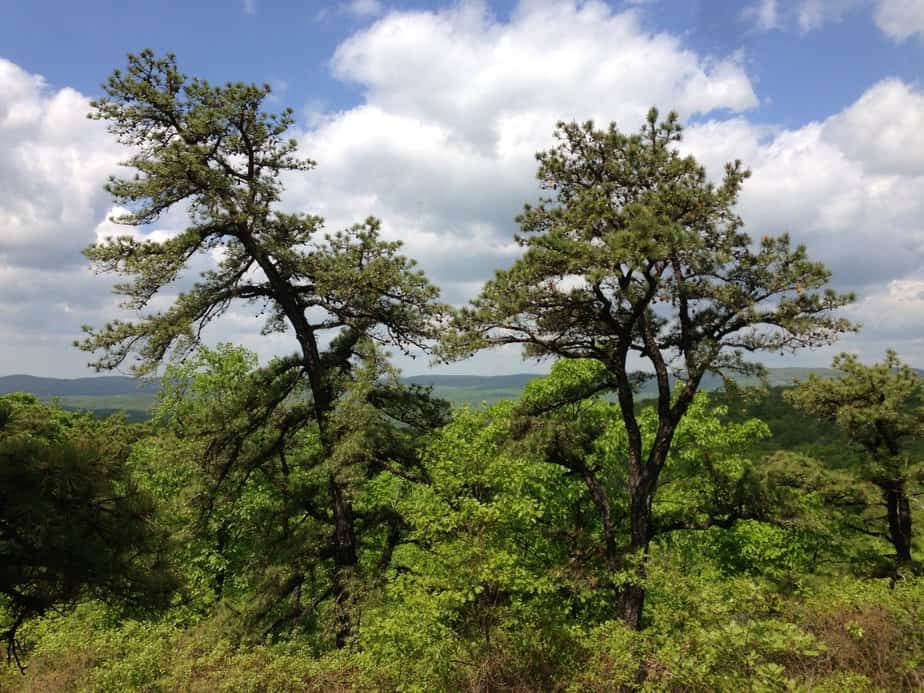
Next is a small- to medium-sized, evergreen coniferous tree commonly found in the eastern part of North America.
This tree can grow in various environments, including ones that are uninhabitable for other plants and trees.
This pine tree has reddish-brown wood that is hard and coarse-grained. Pitch pine trees rarely reach a large size.
When they do grow large, their wood is used for lumber, which is then used to make crates, rough framing lumber, mine props, and so on.
The pitch pine tree has very thick bark, making it a fire-resistant tree.
36. The Scots Pine Tree

The scots pine (or scotch pine) is an evergreen, coniferous tree that is commonly found in Asia and Europe.
The tree is quite resilient, able to grow in areas with poor quality soils.
Like the balsam fir tree, this tree is also among the most popular options for a Christmas tree.
The scots pine, just like its other pine tree siblings, has brown wood that is thick and coarse-grained. The wood is usually used for framing lumber, pulpwood, and ties.
37. The Red Pine Tree
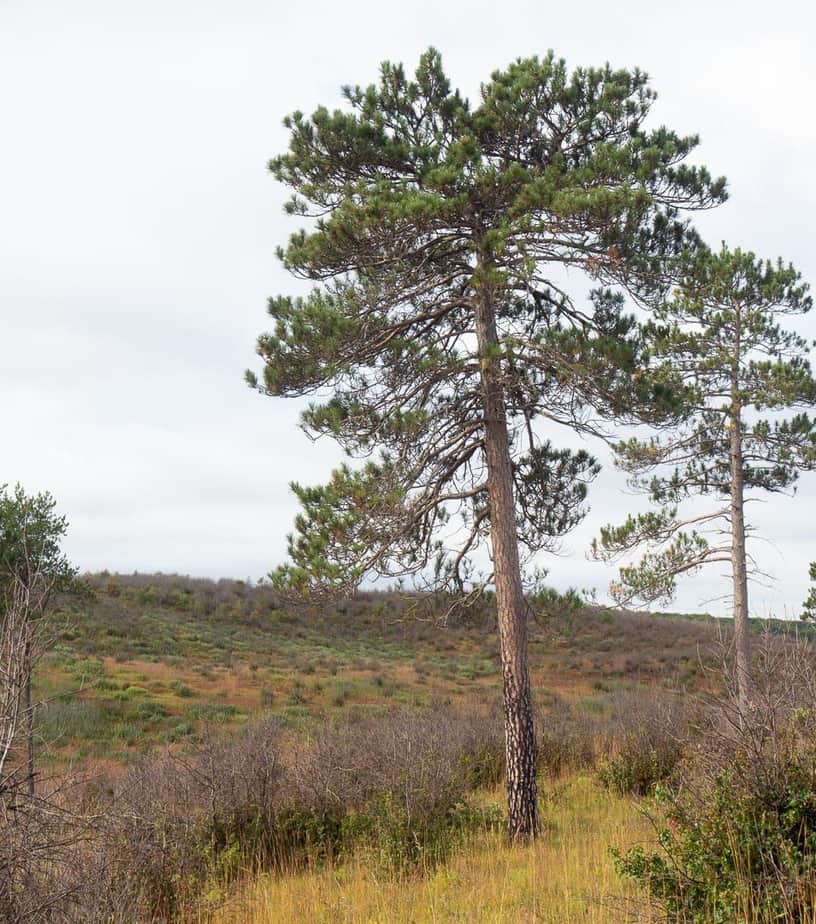
The red pine tree is an evergreen coniferous that can grow to medium to large size. The tree can grow rapidly. It is commonly found in the United Kingdom, the United States, and some parts of Europe.
Much like its pine tree siblings, the red pine tree can survive on low nutrient and sandy soils. It is quite resilient, too.
Its wood has a smooth texture, coarse-grained, and is light. The wood color is red.
Due to its rapid-growing quality, the red pine tree is susceptible to insects and diseases. This is why the trees are often planted in areas far from suburban areas and cities.
38. The Red Spruce Tree
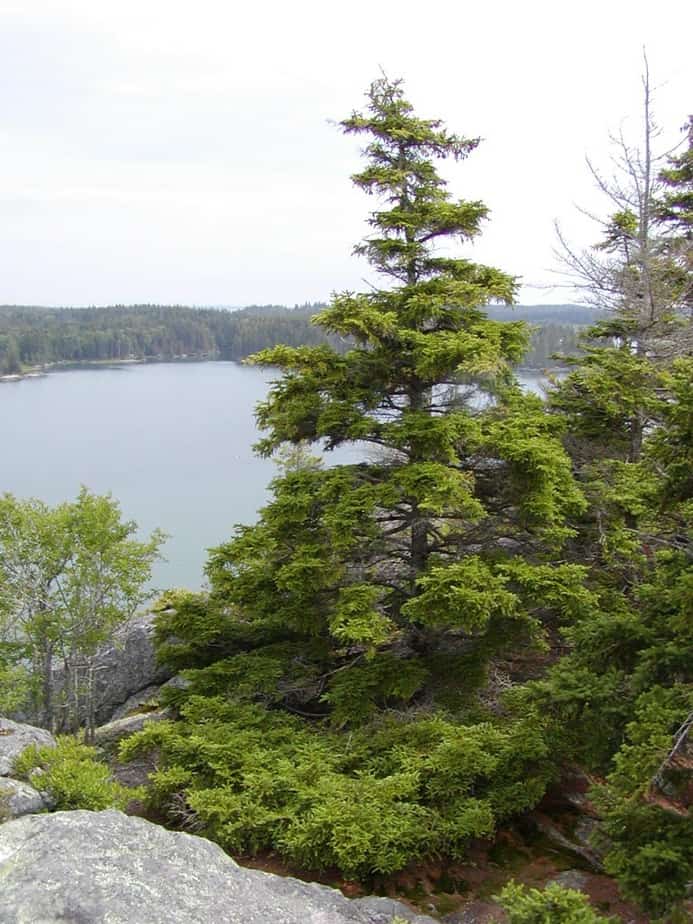
Considered as among the most valuable trees in the United States, the red spruce tree is commonly found in the eastern part of North America as well as some parts of Europe.
The wood of this tree is coarse-grained and soft. It is often used for chemical wood pulp. The wood is also known to have a sound managing quality, which is why it is a solid material for musical instruments.
The bark of the red spruce tree is very thin. It is so thin it can peel off very easily. The needle-like leaves of this tree resemble that of pine trees.
39. The White Spruce Tree
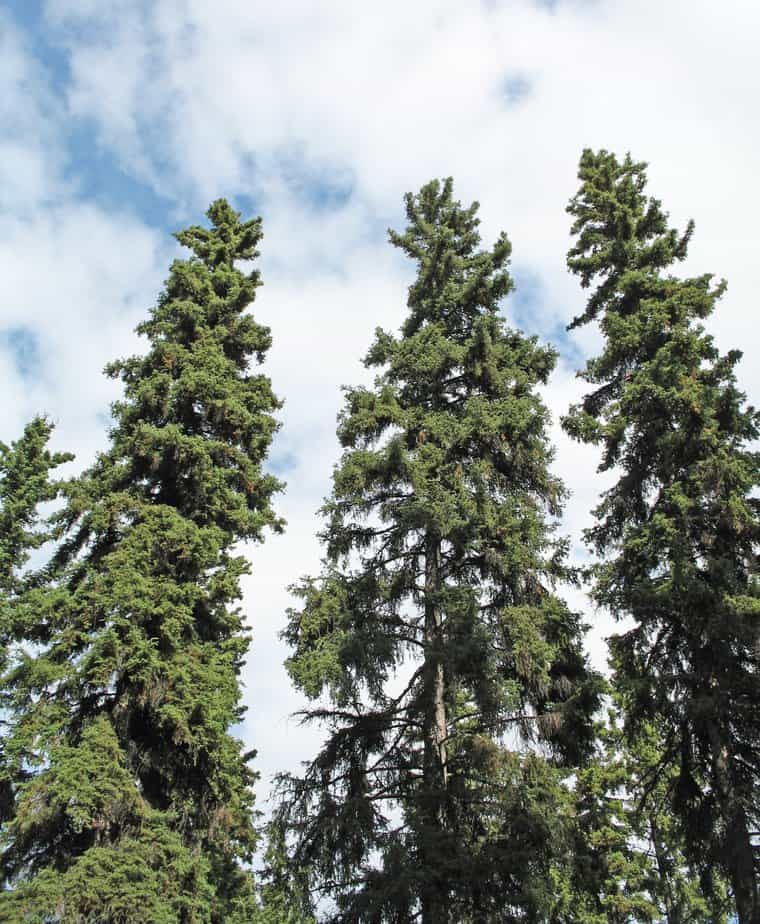
A large, evergreen coniferous tree, the white spruce is a tree commonly found in North America. Specifically, in the boreal forest.
These trees can grow tall and large. They can be found in various areas, from flat grounds to mountain slopes.
Similar to the wood of the red spruce tree, the wood of this tree is great for making chemical wood pulp.
The tree also has attractive foliage, which is why many people use it as an ornamental tree.
The tree has light brown-red bark. The leaves are fragrant, green, shiny, and needle-like.
40. The Eastern Red Cedar Tree

Last but not least, the eastern red cedar tree. This tree is a small-sized, slow-growing, evergreen coniferous tree. The tree is usually found in central and north America.
The tree can grow in poorer quality and dry soils but it thrives in open woods.
The wood of the eastern red cedar tree is very durable, light, soft, and interestingly enough, fragrant.
The wood is also easy to work with, making it a great material to use for interior decorating, cabinet works, cedar chests, and pencils.
These are just some examples of types of trees. There are still many more out there. What do you think about these gentle giants? Aren’t they amazing?
